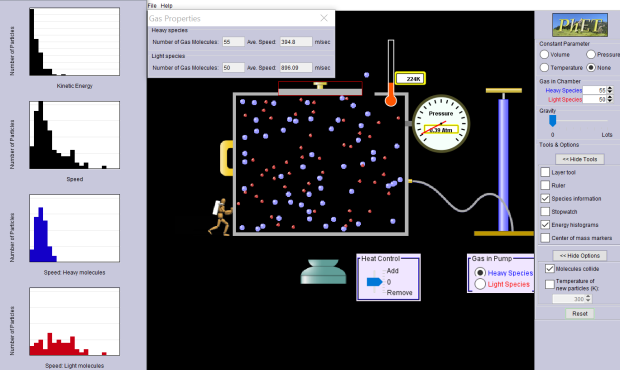Today I want to bring attention to the PhET Gas Properties Simulator. This is a wonderful tool that allows a learner to interact with all of the levers in a gas system. The tool is set up so that the learner can add gas particles into a chamber and then see the results as the system’s parameters (temperature, volume, etc.) are changed.
In the figure below, I introduced equal amounts of a heavy gas and a light gas (60 of each) and then opened the lid on the top of the chamber a bit to see what happens. After letting the simulation run for a short while I could see that the light gas was escaping faster than the heavier gas, the temperature was dropping in the system along with the pressure.

60 heavy gas molecules and 60 light gas molecules were introduced into the chamber. The lid was cracked open and gas was allowed to escape. At the time of the screen shot, 55 heavy gas molecules and 50 light molecules remained in the chamber.
There are also some graphs that give insight of the molecular speeds and energies of the molecules. Lessons and exercises are available on the PhET website.
As a vacuum technologist, I think in terms of molecular flow where the molecules interact with the walls of a conduit rather than collide with each other. When opening the lid to allow that gas to expand out into space, it occurred to me that this is also a good tool to help convey the idea that in order for a pump to remove a gas molecule from a chamber, the molecule has to enter the pump’s inlet. Since the lid has a variable aperture, it can be use to introduce the concept of how a high vacuum pump’s pump speed is dependent on the inlet diameter .
The Gas Properties Simulator is suitable for high school, college, and continuing education students. I have loaded it onto my work laptop and will be using this in my corporate vacuum lectures in the future. I hope you will find it useful too.
Understanding Modern Vacuum Technology discusses the gas properties that can be explored with this simulator. UMVT also discusses vacuum pumps and pressure measurement.